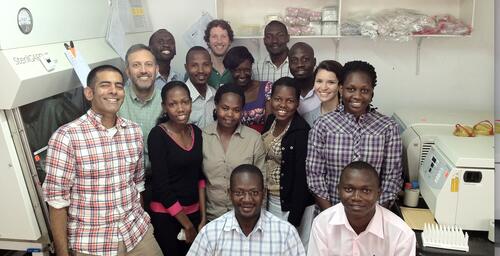African-American doctors could help reduce cardiovascular mortality among black men by 19 percent — if there was more racial diversity among physicians, according to a new study led by Stanford Health Policy’s Marcella Alsan.
After conducting a randomized clinical trial among 1,300 black men in Oakland, the researchers found that the men sought more preventive services after they were randomly seen by black doctors for a free health-care screening compared to non-black doctors.
“We found that, once African-American men were at the clinic, even though all services were free, those assigned to a black doctor took up more services,” such as flu shots and diabetes and cholesterol screenings, said Alsan, an economist and infectious disease physician who focuses on health and socioeconomic disparities here at home and around the world.
“It was surprising to see the results,” said Alsan, an associate professor of medicine at Stanford Medicine, a faculty fellow at the Stanford Institute for Economic Policy Research, and an investigator at the VA Palo Alto Health Care System. “Prior to doing the study, we really were not sure if there would be any effect, much less the magnitude. The signal in our data ended up being quite strong.”
Those signals include the men were 29 percent more likely to talk with black doctors about other health problems and seeking more invasive screenings that likely required more trust in the person providing the service. They found subjects assigned to black doctors increased their uptake of diabetes and cholesterol screenings by 47 percent and 72 percent, respectively.
The researchers calculated that black doctors could reduce cardiovascular mortality by 16 deaths per 100,000 per year, accounting for 19 percent of the black-white gap in cardiovascular-related deaths. They believe that the results would be even larger if extrapolated to other leading causes of death that are amenable to prevention, such as cancer and HIV/AIDS.
“I was definitely surprised,” said Owen Garrick, president and COO of Bridge Clinical Research, an Oakland-based organization that helps clinical researchers find patients from targeted ethnic groups. “If you ask most people, they feel that there is some impact of black men seeing black doctors — but it has never been quantified using an experimental design.”
Alsan and Garrick, along with U.C. Berkeley graduate student Grant Graziani, published their findings in this working paper for the National Bureau of Economic Research.
Garrick, himself an African-American physician, said black doctors tend to present themselves in a manner that puts a black patient at ease, making him more willing to open up and agree to certain care. “The black doctor might explain the medical services in a way that the black patient more clearly understands.”
Garrick called the findings “astounding,” but he warned that increasing the number of black doctors and getting black men to routinely see them are no small tasks.
There is a yawning gap between white physicians and those of color. While African-Americans comprise about 13 percent of the population, only 4 percent of physicians and less than 6 percent of medical school graduates are black, according to the study.
This is compounded by African-American men having the lowest life-expectancy in the country, due to lack of health insurance, lower socioeconomic status and structural racism.
And there remains a distrust of the U.S. healthcare system at least partially attributed to the infamous Tuskegee study that began in 1932, when the U.S. Public Health Service began following about 600 African-American men in Tuskegee, Alabama. Some two-thirds of the men had syphilis, and USPHS declined to inform those afflicted by the disease. Even after penicillin became the standard of care for syphilis treatment in the mid-1940s, the USPHS continued to withhold treatment. The study was finally halted when a whistleblower went to the press in 1972.
Alsan— with her colleague Marianne Wanamaker at the University of Tennessee — published a study in The Quarterly Journal of Economics in February that found the 1972 Tuskegee study revelation was correlated with a reduction in health-seeking behavior and increases in medical mistrust and mortality among African-American men.
The men who participated in the recent study were recruited from barbershops and flea markets in Oakland, a city known for its diversity, yet plagued by a 20 percent rate of poverty.
Field officers —including minority and low-income pre-med students from around the Bay Area — approached men to enroll in the study. After obtaining written consent, the men were given a short survey about socio-demographics, health care and mistrust. For completing the survey, the men received a voucher with up to $25 for their haircut or, in the flea market, a cash incentive.
The men were also given a coupon to receive a free health-care screening for blood pressure, BMI, cholesterol and diabetes at the clinic where the Stanford team operated on Saturdays in the fall and winter of 2017-2018. The patients who did not have transport to the clinic were given free rides courtesy of Uber. Attendance at the clinic was encouraged with another $50 incentive.
Subjects and the 14 participating doctors were told that they were taking part in a Stanford study designed to improve preventive health-care for African-American men.
On top of the significant increases in patients who agreed to diabetes or cholesterol screenings if suggested by a black doctor, the researchers found that the men were 56 percent more likely to get a flu vaccine if randomized to one of the African-American doctors.
The results suggested the more invasive the test, the greater the advantage of being assigned a black doctor. And the findings were even stronger among subjects who had a high mistrust of the medical system as well as those who had limited prior experience with routine medical care.
“In curative care, the patient feels ill and then may seek out medical care to fix the problem,” Alsan said. “But in preventive care, the patient may feel just fine — but must trust the doctor when he is told that certain measures must be taken to safeguard health.”
The policy implications would suggest that medical schools need to open the pipeline to students from diverse backgrounds who are training for health-care professionals.
Garrick recommends exposing more young people of color to the field of medicine and helping them to become more competitive applicants through tutoring and interview prep.
“And you need advocates,” he said. “Since much of the medical school selection process is subjective, you need to get people on the selection committees who will relate and see the potential of black applicants as much as people relate to other applicants.”
Some links to other media outlets that have written about this research:
The New York Times
Harvard Business Review
The Daily Mail
ColorLines


